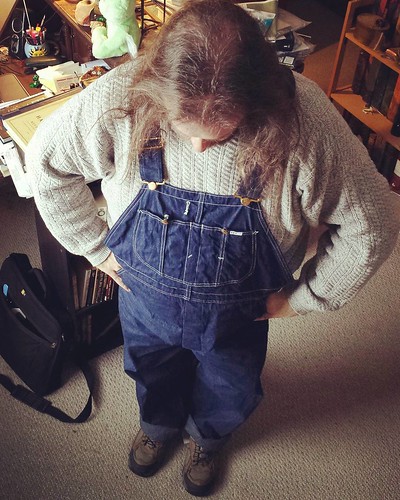
But lately I've discovered another pleasure: raw denim. I know, I know -- raw denim is stiff and unforgiving. Its color is uniform, with none of the wear of use. Wearing it, raw denim doesn't hang correctly and doesn't conform to your body the way broken-in denim does.

That, however, is part of the charm.
I have, of course, discovered this by several lucky purchases of raw denim overalls.
You can find raw denim overalls pretty easily. Any Tractor Supply store or other workwear establishment will have them. (A good local place is McKay's Work Clothing in South Buffalo.) Vintage raw denim overalls are another matter. They often go for princely sums that are way higher than I'm willing to pay for such things, but it's always the case with places like eBay that you never know. You might go months without seeing a good deal on the thing that you want, and then one day, there it is, and for a decent price, too. This happened for me twice in the last year, when I was able to buy two different pairs of raw denim Lee overalls for a song (both for less than what a new pair of Carhartts would set me back these days).
The Lee overalls of the "vintage" era, roughly the 50s through the 80s, have always been my "platonic ideal" of what overalls should be. I love the shape of the bib pocket, the shape of the back part, even the shape of the back pockets and the brass hardware. When I think of overalls, this is what I tend to picture.
(Photos chosen via a Google image search.)
I've owned several pairs of Lee overalls for years now, two in blue denim and one in hickory stripe.



These were all nicely broken-in when I bought them, but now I've acquired two in unworn, pristine raw denim. They even came with the tags attached:

What's so great about raw denim? Its deep blue is almost black, and the fabric is stiff. Oh my, is it stiff! But the denim is a wonderful super-dark blue with no fade at all, and no creasing anywhere. The pleasure, here, is in the working with "raw" material (hence the name!). It's the denim equivalent of cooking from scratch, or building a piece of furniture not from a pre-cut kit but from uncut lumber. As another writer puts it:
Raw denim is a true nerd’s category of clothing, the rare subset of fashion that is the domain mostly of men, and thus overrun by complicated terminology and geeks eager to tell you you’re doing it wrong. Basically, though, what “raw” amounts to is denim that wasn’t washed to soften it up (and remove excess indigo dye) before it was sent out into the world — though mine had been Sanforized, or soaked, to pre-shrink them. Raw denim is also usually made of nearly pure cotton — so minimal-to-no Lycra or spandex or what have you, the stuff that gives stretchy jeans their elasticity. What you lose in immediate flexibility, you gain in durability: They’re harder to stretch, but also harder to stretch out. My pair arrived on my doorstep deep blue, stiff, and difficult. Then it became my job to find the patience and persistence to wear them into shape.
There's a process with raw denim, it turns out: you're actually not supposed to just toss them into the washer and dryer right off the bat, nor are you supposed to wash them frequently. An initial soaking-and-drying, without soap, followed by wearing a lot with intermittent re-soakings and gentle washings (hand-washing in a tub with a bit of soap is recommended) followed by line-dryings only, is what's called for. In this way the denim will slowly break in and wear in exact ways that correspond to your body and the way you wear it.
Here's how the ran denim overalls compare, side-by-side with one of my long-broken-in pairs:

Step one is to put them in the bathtub and hose them off to rinse out as much of the extra dye as possible (I'd have done this outside but the weather was crappy on the day in question):


Then I soak them in a bucket for most of a day, periodically wringing them out and changing the water.

(I was doing to same treatment with a new pair of hickory-striped Dickies.)
Last, they hang on the line to dry. This takes forever. When you thoroughly soak denim, it holds water for a long time. This is not a process for the impatient.

The result of all this? Well, once dry, you can wear them. The look is great, in my opinion: the denim is still new and dark, with some new wrinkling already starting after the initial soaking and rinsing of the dyes.





Now, if I could just get the weather in my neck of the woods to dip reliably into the 60s, I'd be all set!



Eaw, raw, raw - that's the spirit!
ReplyDelete